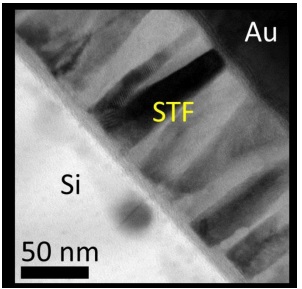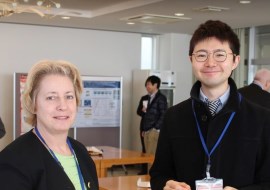17 Mar 2017
To realize the next generation of devices for information processing based on new phenomena such as spintronics, multiferroics, magnetooptics, and magnonics, their constituent materials need to be developed. Recent rapid progress in nanotechnology allows us to fabricate nanostructures that are impossible to obtain in nature.
However, complex magnetic oxides are one of the most complicated material systems in terms of development and analysis. In addition, the detailed mechanism is unknown by which changes in atomic composition that do not affect overall structure lead to drastic changes in material characteristics even though the material structure is similar.
Now, researchers at Spin Electronics Group at Toyohashi Tech and at Myongji University, Harbin Institute of Technology, Massachusetts Institute of Technology, Universidad Técnica Federico Santa María, University of California, San Diego, and Trinity College Dublin found that nanoscale pillar-shaped distribution of iron in strontium titanate (STF) changes its magnetic and magnetooptical response drastically. Surprisingly, the polycrystalline sample showed stronger magnetism than single crystalline film.
“In usual oxide systems, magnetic and magnetooptical effects are stronger in highly ordered structures. In other words, single crystalline material is better for obtaining better magnetic properties,” explains Assistant Professor Taichi Goto, “However, iron-substituted strontium titanate deposited at certain oxygen pressure is different.”
The STF films were prepared by pulsed laser deposition at various pressures directly on silicon substrate, and crystalline structure and magnetic properties were characterized systematically. A sample deposited at a certain pressure showed significantly stronger magnetism and larger Faraday rotation angle (magnetooptical effects) at room temperature. Several tests analyzing the oxygen stoichiometry and the corresponding Fe valence states, the structure and strain state, and the presence of small-volume fractions of iron revealed that the nanostructure and clustering of the elements enhanced magnetism.
These results show the broad possibility of polycrystalline films being used in silicon-based devices. In this paper, the integration of STF film with 0.1 mm scale optical resonator was demonstrated. Further, the integration of such novel oxides with conventional device concepts would pave a way for interesting systems in the future.

Image of nanopillar-like poly-crystalline STF film obtained by transmission electron microscopy.
Funding agency:
T. G. acknowledges support from the JST PRESTO, JSPS Postdoctoral Fellowships for Research Abroad, Grant-in-Aid for Young Scientists (A) No. 26706009, and Challenging Exploratory Research No. 26600043. C. R. acknowledges support from the NSF DMR1419807 and ECCS1607865 and from FAME, a SRC STARnet Center supported by DARPA and MARCO. H. L. T. acknowledges support from the NSF DMR1419807. P. V. acknowledges support from the Center for Development of Nanoscience and Nanotechnology, CEDENNA, Chile. J. M. F. acknowledges support from Fondecyt Iniciación 11130128 and DGIIP USM, Chile. M.I. acknowledges support from the JSPS Grant-in-Aid for Scientific Research (S) No. 26220902. This work utilized the shared experimental facilities of the Center for Materials Science and Engineering (CMSE), Award 024006-10 No. NSF DMR1419807.
Reference:
Taichi Goto, Dong Hun Kim, Xueyin Sun, Mehmet C. Onbasli, Juan M. Florez, Shyue Ping Ong, Patricio Vargas, Karl Ackland, Plamen Stamenov, Nicolas M. Aimon, Mitsuteru Inoue, Harry L. Tuller, Gerald F. Dionne, J. Michael D. Coey and Caroline A. Ross, "Magnetism and Faraday rotation in oxygen-deficient polycrystalline and single-crystal iron-substituted strontium titanate", Phys. Rev. Applied, 7, 024006 (2017/02/08). https://doi.org/10.1103/PhysRevApplied.7.024006













